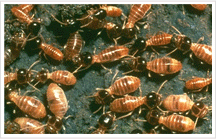

Toronto Termite Inspection Service
Termite Inspection in Toronto is recommended to be conducted annually and before buying or selling a home; it is

particularly important if a suspicion of termite infestation arises. Termite infestation causes staggering $120,000,000 of property damage in the Greater Toronto Area annually.
Free Estimate
If you suspect you might have a termite infestation, contact Cain pest Control for a free consultation or termite inspection service in Toronto.
FAQ – Frequently Asked Questions
What is a Toronto termite inspection service?
A Toronto termite inspection service is a visual inspection of easily accessibly areas of a home aimed at revealing any evidence of wood-destroying insects and organisms. A qualified Cain Pest Control inspector will inspect the interior and exterior of the property in question, including any sub-spaces such as basements and crawlspaces. The attic may also be inspected in areas where drywood termites are present. After the completion of the inspection all findings are reported on the applicable form.
How long is a Toronto termite inspection?
On average a termite inspection takes approximately 30-45 minutes, this number may vary due to difference in property size, clutters, storage of personal items and other reason that may potentially delay the inspector.
Can termites survive in colder climates?
Yes, termites find habitat throughout the US and Canada, even ranging to the most northern points as Alaska. Cold temperatures do not kill termites, rather causing them to hibernate. It may come as a surprise that 1 out of 18 households in the Greater Toronto Area suffers from termite infestation.
Why inspect the attic?
Cain Pest Control termite inspection is targeted at revealing all wood-destroying insects and organisms. Toronto termite inspection will also reveal ants, bugs and fungus if present. Cain Pest Control inspectors routinely inspect the attic in areas where drywood termites are present for pallets (fecal matter). They generally appear on the surface or in spider webs.
What do termites look like?
Subterranean termite colonies are broken down into three casts: soldiers, workers and reproducers. They are generally creamy white in visual appearance and resemble grains of rice. The reproducers are often confused for flying ants as they are equipped with a pair of wings. The solider termites have oversized heads and large crushing mandibles.
How can you distinguish carpenter ants from termites?
The body shape of a carpenter ant is reminiscent of an hourglass, while a body of a termite resembles a cigar-shape without narrowing. If wings are present, carpenter ants have large wings in the front and smaller wings in the back, while termites have equal-sized wings. Ant wings have dark spots on the leading edge of the front wing, while termite wings do not. Additionally, carpenter ant antennae are curved or bent while termite antennae are relatively straight. Most importantly, termites eat the wood they tunnel through while ants do not.
How do you treat termites?
There are several approaches to treating subterranean termites. Most commonly a chemical treatment is implemented with the general goal of establishing a continuous termiticide barrier between the termite colony and the wood in a building. Cain Pest Control will create a protective barrier around your property with the following steps:
- trenching the soil and injecting the termicide beneath it at 16-inch intervals, thus providing a barrier that prevents termites from entering the structure
- Cain Pest Control specialists will drill into the hollow masonry block foundations and inject termicide into the block voids.
In-ground subterranean baiting systems are another effective mean of combating a termite infestation. The setup of a subterranean termite baiting system consists of strategic wood material bait station placements around the home?s perimeter. Worker termites, upon discovering the bait, leave scent trails to summon their mates to the food source. Upon the completion of the above step, the wood material is replaced with a chemical inhibitor, which prevents termites from growing, worker termites will carry the inhibitor back to their colony causing it to die out.
Could there be hidden termite damage?
Yes! Termites and termite colonies avoid open air and bright lights, thus staying underground or within wood. Remember ? termites eat the wood they tunnel through, often causing the majority of their damage from the inside. It is nearly impossible to identify or locate any termite infestation by just looking at the finished surface of a wall, that is why Cain Pest Control termite inspectors conduct a extensive investigation.
How do I prevent a termite infestation?
The newly imposed standard method of termite infestation prevention is spraying liquid termiticide over the foundation area prior to concrete being poured. New termite prevention techniques are constantly emerging, a Cain Pest Control specialist will be able to inform you of the latest industry innovations. Post-constructive adjustments aimed at preventing an infestation of wood-destroying insects are also available. Conditions that most commonly cause a termite infestation are: earth to wood contact at support posts, boards left in crawlspaces and cellulose debris, improper drainage, inadequate ventilation in crawlspaces. Making adjustments to correct those errors will drastically reduce the possibility of a termite infestation in Toronto.
If you think you may have a termite infestation or if you buying or selling a home, contact Cain Pest Control for a free consultation or for more information about termite inspection services in GTA.
